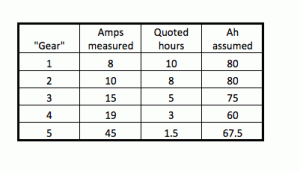24th Oct: Even more Electric Outboard tests!
 As a contribution to discussions on the Swallow Boats Association forum, today I did some measurements of power consumption for my the Minn-Kota Rip Tide 40. It was mounted on the back of my Seafly moored in its normal position on the jetty. Power was from the fully charged, fairly new, 100Ah Yuasa “Marine” battery which I’ve removed from Seatern. It has deep-discharge and traction capability (whatever the latter means).
As a contribution to discussions on the Swallow Boats Association forum, today I did some measurements of power consumption for my the Minn-Kota Rip Tide 40. It was mounted on the back of my Seafly moored in its normal position on the jetty. Power was from the fully charged, fairly new, 100Ah Yuasa “Marine” battery which I’ve removed from Seatern. It has deep-discharge and traction capability (whatever the latter means).
 The results are shown in the table where:
The results are shown in the table where:
- “Gear” is the speed setting (1 to 5).
- “Amps Measured” were read using my model boat Watt meter in series with the motor. These decreased during the relatively short test as the supply volts dropped from 12.6V to around 11.7V. This was no doubt due to pulling up to 52A from the battery at full power; on the second run it had dropped to 42A, the figures shown are a rough average.
- “Quoted hours” are as printed on the top of the motor control pod.
- “Ah assumed” is the implied practical capacity of a 12V 100Ah battery,for example at speed setting 1 Minn-Kota are assuming that 80% of the nominal battery capacity is actually usable.
The duration values displayed on the Minn-Kota therefore seem fairly reasonable except maybe for the higher speed settings. Drawing 40A to 50A from a 100Ah lead acid battery is not going to do it much good. However, as observed during my test, the result is to lower the battery voltage and hence the current drawn. So maybe it would go on for 1.5 hours at full power but at the expense of ruining the battery. This also implies that my estimate of 12kg bollard pull at full power would not be available for the full 1.5 hours – it is an over estimate.
Admittedly my Minn-Kota was bought a few years ago and has been used quite a bit. I don’t know how it’s performance compares to a brand new up to date motor (however they seem in the same ball park as those quoted on the Flover Outboard motor web site *).
I hadn’t heard of Flover Outboards before. They say that their 55 (lbs thrust) model draws max 45A to produce 25kg thrust “in bench tests” and 47A to produce 14kg in a “field test”. These figures again confirm Torqeedo’s claim that the thrust quoted for trolling motors is an over-estimate by 150% or more compared to what is achieved.
Sadly, and with much regret, I’m becoming more and more convinced that small electric outboards don’t have the capabilities needed for use on the sea – or anywhere where there is a significant wind or current. Flover say their largest outboard will propel a 20′ yacht at 3mph (2.6 kt)… that’s not enough!
* Note added August 2017: this web site now directs to a Marine Imports web site where only 4 stroke and 2 stroke (sic) “Parsun” outboards are listed although there is a video of an electric outboard working off about 50V!
